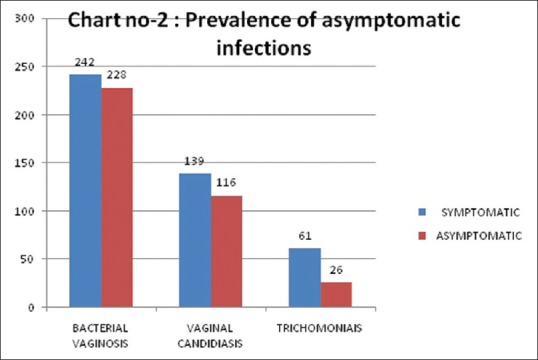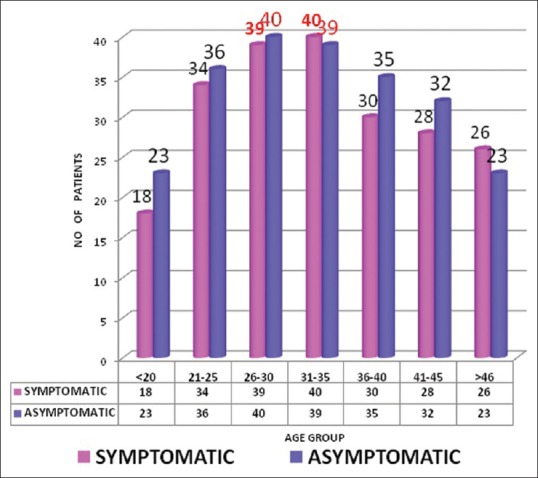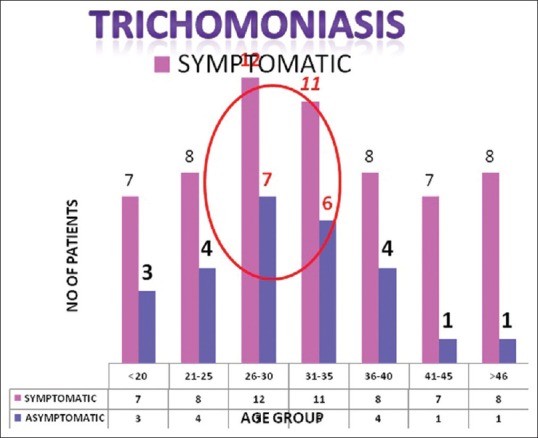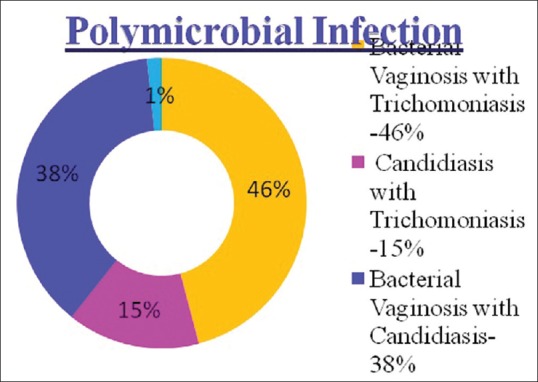Abstract
Background:
Sexually transmitted diseases (STD) are a major health problem affecting mostly young people in both developing and developed countries. STD in women causes both acute morbidity and complications such as infertility, ectopic pregnancy, low-birth weight, and prematurity.
Aims:
The aim of the study is to assess the prevalence of bacterial vaginosis, vaginal candidiasis, and trichomoniasis among asymptomatic females attending STD outpatient department in a tertiary care hospital in South India.
Materials and Methods:
A retrospective analysis of data collected from clinical records of 3000 female patients of age 18 to 49 over a period of 12 months (July 2014 to June 2015) was carried out at the Institute of Venereology, Madras Medical College. Complete epidemiological, clinical, and investigational data were recorded and analyzed for the prevalence of bacterial vaginosis, vaginal candidiasis, and trichomoniasis among asymptomatic patients.
Results:
About 48.37% (228/470) of bacterial vaginosis patients were asymptomatic. Nearly 45.38% (116/235) of vaginal candidiasis patients were asymptomatic and 30.35% (26/87) of trichomoniasis patients were asymptomatic. The above infections were common in the age group 25–35.
Conclusion:
Holistic screening protocol was incorporated for all female patients attending STD clinic even if asymptomatic and should be treated accordingly to prevent the acquisition of other serious sexually transmitted infections.
Key words: Bacterial vaginosis, trichomoniasis, vaginal candidiasis, vaginal discharge
INTRODUCTION
The genital tract is the portal of entry for numerous sexually transmitted diseases (STD).[1] A number of vaginal infection present with few or no symptoms and yet produce serious effect and can be transmissible to other people.[1] An abnormal vaginal discharge is a common complaint in women, and it can be due to vaginal infections such as bacterial vaginosis, candidiasis, and trichomoniasis.[2] These vaginal infections increase susceptibility to STD, including HIV. It is associated with complications such as infertility, ectopic pregnancy, low birth weight and prematurity. The normal vaginal ecosystem depends on the balance of hormones and bacterial. Bacterial vaginosis is reported to be the most common form of vaginitis in gynecologic out-patients and STD attenders. Bacterial vaginosis is a complex polymicrobial syndrome that lacks an identified etiological agent.[3] It is characterized by increased vaginal pH and replacement of lactobacilli, particularly those that produce hydrogen peroxide with Gardnerella vaginalis and anaerobic Gram-negative rods.[4] Vulvovaginal candidiasis is caused by the overgrowth of candida species. Pathogenic candida species that cause vaginitis most often are Candida albicans, Candida glabrata, and Candida tropicalis.[5,6] Trichomoniasis is caused by flagellated protozoan parasite Trichomonas vaginalis. It can cause vaginal irritation, pruritus, and malodorous discharge though asymptomatic carriage is common. It may play a critical and under-recognized role in amplifying HIV transmission and, in some circumstances, may have a major impact on the epidemic dynamics of HIV infection and AIDS in the world.[7]
Aim of the study
The aim of this study is to assess the prevalence of bacterial vaginosis, vaginal candidiasis, and trichomoniasis of asymptomatic female patients attending STD out-patient department in a tertiary care hospital in South India.
MATERIALS AND METHODS
A retrospective analysis of data collected from clinical records of 3000 female patients of age 18–49, of which 1564 were symptomatic and 1436 were asymptomatic, over a period of 12 months (July 2014 to June 2015), was carried out at Institute of Venereology, Madras Medical College and Rajiv Gandhi Government General Hospital, Chennai. Asymptomatic patients included in the study are those patients who were referred from other departments in our hospital for screening and symptomatic patients are those who presented with complaints of vaginal discharge.
Inclusion criteria
Females of age 18–48 attending Institute of Venereology for screening
Those who were willing for speculum examination.
Exclusion criteria
Those who were not consenting to speculum examination
Women who were menstruating
Women who were pregnant.
Consecutive patients who satisfied the inclusion criteria were included in the study, and others were excluded from the study. Detailed history, demographical data, and clinical features were recorded from all the patients. Lab investigation reports of all patients [Table 1] including Gram-stain, Wet mount for normal saline and 10% potassium hydroxide, vaginal pH test, and amine test were also recorded. The data collected were analyzed statistically to know the prevalence of bacterial vaginosis, vaginal candidiasis, and trichomoniasis among asymptomatic patients.
Table 1.
Microscopic examination profile of study participants

RESULTS
In the study period, 4372 females attended the female STD clinic. Of these, 3000 (68.61%) fulfilled the inclusion criteria and were included in the study. In our study population, the overall most common reproductive tract infection was bacterial vaginosis among the three diseases studied. Next common infection in our study group was vaginal candidiasis and the least common among our study group was trichomoniasis. Out of all the patients who tested positive for any of the above listed 3 conditions, 59.59% (470/792) patients had bacterial vaginosis. About 14.65% (235/792) were suffering from vaginal candidiasis and 10.9% (87/792) were suffering from trichomoniasis. Out of the total study population who were tested for any of the three conditions mentioned, 15.67% (470/3000) were diagnosed with bacterial vaginosis, 7.83% (235/3000) were suffering from vaginal candidiasis, and 2.9% (87/3000) were suffering from trichomoniasis.
In our study group, 48.37% (228/470) of bacterial vaginosis patients were asymptomatic. Nearly 45.38% (116/235) vaginal candidiasis patients were asymptomatic and 30.35% (26/87) of trichomoniasis patients were asymptomatic as shown in Figure 1. The majority of patients affected belonged to the age group 26–35 years [Figures 2–4]. Figures 2–4 show age-wise prevalence of bacterial vaginosis, vaginal candidiasis, and trichomoniasis, respectively.
Figure 1.

Prevalence of diseases in study group
Figure 2.

Age-wise prevalence of bacterial vaginosis in study group
Figure 4.

Age-wise prevalence of trichomoniasis in study group
Figure 3.

Age-wise prevalence of vaginal candidiasis in study group
A total of 100 patients had coinfections in the study group. Of which bacterial vaginosis with trichomoniasis was the most common associated infection found in our study group. It accounted for nearly 46% (46/100) cases. Next commonly observed coinfection was bacterial vaginosis with candidiasis which accounted for 38% (38/100) cases. All the three diseases studied were present in 1% (1/100) of cases [Figure 5].
Figure 5.

Prevalence of coinfections in study group
DISCUSSION
Vaginal discharge is one of most frequent gynecological problems encountered in females, especially during their reproductive stage.[7] Vaginal discharge is a common health problem among women in the reproductive age. It is usually neglected by women making the diagnosis more difficult.
Bacterial vaginosis is characterized by replacement of normal lactobacillus flora with anaerobic and facultative bacteria overgrowth associated with rise in pH >4.5. Bacterial vaginosis was found to be the most common cause of vaginal discharge in our study; there are a few studies where a higher prevalence of bacterial vaginosis was reported. Bhalla et al., New Delhi, studied on the prevalence of bacterial vaginosis among women in Delhi [8] and Mathew et al., Kanchipuram, studied on the microbiological profile of vaginosis among women of the reproductive age group.[9] According to Bhalla et al. study done in New Delhi, bacterial vaginosis was diagnosed in 32.8% subjects. A high percentage (31.2%) though asymptomatic was found to have bacterial vaginosis. According to Renu et al. study, bacterial vaginosis was found to be the most prevalent (36.4%) form of vaginosis which affected women of the reproductive age group.
About 70–75% of women will have at least one lifetime episode of vulvovaginal candidiasis, with 40–50% suffering from a recurrence.[10] The overall prevalence of vaginal candidiasis in the study group was 7.8% which almost coincides with 7.5% of Pawanarkar and Chopra study, who studied the prevalence of lower reproductive tract infection among infertile women in New Delhi.[11] However, the prevalence of vaginal candidiasis in our study group was slightly less compared to 9.3% in Gupta et al. study.[12]
The infection with T. vaginalis is one of the most common STDs in humans. The prevalence of this infection has been reported to be between 2% and 8%, depending on the different sociocultural conditions.[7] The overall prevalence of trichomoniasis in the study group was 2.9% which correlates with 2.1% of Vijaya Mn et al. study who studied the prevalence of T. vaginalis infection in rural Bengaluru.[7]
CONCLUSION
Asymptomatic women are less likely to seek treatment for the morbidity and thus are more likely to acquire other serious sexually transmitted infections (STIs). In view of this, it is therefore recommended that a holistic screening protocol is incorporated for all female patients attending STD clinic even if asymptomatic and should be treated accordingly to prevent the acquisition of other serious STIs. Proper, early diagnosis and treatment can prevent complications associated with vaginal infections. An appropriate health education is also very imperative particularly to high-risk group, that includes awareness about various STI, HIV, and safe sex to prevent patients from acquiring STI.
Financial support and sponsorship
Nil.
Conflicts of interest
There are no conflicts of interest.
REFERENCES
- 1.Akingbade OA, Akinjinmi AA, Awoderu OB, Okerentugba PO, Okonko IO. Prevalence of Candida albicans amongst women attending health centres in Abeokuta, Ogun State, Nigeria. N Y Sci. 2013;6:53. [Google Scholar]
- 2.Fox KK, Behets FM. Vaginal discharge. How to pinpoint the cause. Postgrad Med. 1995;98:87–90. [PubMed] [Google Scholar]
- 3.Filho DS, Diniz CG, Silva VL. Bacterial vaginosis: Clinical, epidemiologic and microbiological features. HU Rev Juiz de Fora. 2010;36:223–30. [Google Scholar]
- 4.Ajani G, Oduyebo O, Haruna M, Elikwu C. Nugent scores of pregnant women in a tertiary institution in Nigeria. Adv Microbiol. 2012;2:531–6. [Google Scholar]
- 5.Nurat AA, Bahalola GO, Shittu MO, Tijani AM, Adekola SA. Detection and epidemiology of vulvovaginal candidiasis among asymptomatic pregnant women attending a tertiary hospital in Ogbomoso, Nigeria. Int J Biomed Res. 2015;6:518–23. [Google Scholar]
- 6.Radomir Zivadinovic, Aleskandra Petric, Dane Krtinic, Vaginal candidiasis – Gynaecological aspect of the problem. Acta Med Medianae. 2014;53:46–51. [Google Scholar]
- 7.Vijaya Mn D, Umashankar K, Sudha, Nagure AG, Kavitha G. Prevalence of the Trichomonas vaginalis infection in a tertiary care hospital in rural Bangalore, Southern India. J Clin Diagn Res. 2013;7:1401–3. doi: 10.7860/JCDR/2013/5375.3140. [DOI] [PMC free article] [PubMed] [Google Scholar]
- 8.Bhalla P, Chawla R, Garg S, Singh MM, Raina U, Bhalla R, et al. Prevalence of bacterial vaginosis among women in Delhi, India. Indian J Med Res. 2007;125:167–72. [PubMed] [Google Scholar]
- 9.Mathew R, Sudhakrishna R, Kalyani M, Jayakumar S, Lal B, Banu S. The microbiological profile of vaginosis among women of the reproductive age group, who attended a tertiary care hospital. J Clin Diagn Res. 2011;5:1548–52. [Google Scholar]
- 10.Ringdahl EN. Recurrent vulvovaginal candidiasis. Mo Med. 2006;103:165–8. [PubMed] [Google Scholar]
- 11.Pawanarkar J, Chopra K. Prevalence of lower reproductive tract infection in infertile women. Health Popul Perspect Issues. 2004;27:75. [Google Scholar]
- 12.Gupta V, Chatterjee B, Prasad D. Clinical spectrum and microbial etiology of reproductive tract infections in rural women in the hills of North India. J Obst Gynaecol India. 2002;52:130–4. [Google Scholar]


